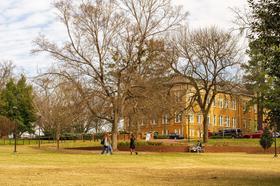Serving 791 students in grades 6-8, John Hopkins Middle School ranks in the bottom 50% of all schools in Florida for overall test scores (math proficiency is bottom 50%, and reading proficiency is bottom 50%).
The percentage of students achieving proficiency in math is 47% (which is lower than the Florida state average of 52%). The percentage of students achieving proficiency in reading/language arts is 34% (which is lower than the Florida state average of 52%).
The student-teacher ratio of 19:1 is higher than the Florida state level of 17:1.
Minority enrollment is 64% of the student body (majority Black), which is lower than the Florida state average of 65% (majority Hispanic and Black).
Quick Facts (2025-26)
- School Type: Magnet School
- Grades: 6-8
- Enrollment: 791 students
- Student-Teacher Ratio: 19:1
- Minority Enrollment: 64%
- Overall Testing Rank: Bottom 50% in FL
- Math Proficiency: 47% (Btm 50%)
- Reading Proficiency: 34% (Btm 50%)
- Science Proficiency: 30-34% (Btm 50%)
- Source: National Center for Education Statistics (NCES), FL Dept. of Education
School Overview
John Hopkins Middle School's student population of 791 students has stayed relatively flat over five school years.
The teacher population of 41 teachers has stayed relatively flat over five school years.
School Type
Grades Offered
Grades 6-8
(No virtual instruction)
(No virtual instruction)
Total Students
791 students
Gender %
Total Classroom Teachers
41 teachers
School Calendar
School Motto
Use Trojan PRIDE for 100% student success
School Rankings
John Hopkins Middle School ranks within the bottom 50% of all 3,662 schools in Florida (based off of combined math and reading proficiency testing data).
The diversity score of John Hopkins Middle School is 0.67, which is less than the diversity score at state average of 0.70. The school's diversity has stayed relatively flat over five school years.
Overall Testing Rank
#2544 out of 3662 schools
(Bottom 50%)
(Bottom 50%)
Math Test Scores (% Proficient)
47%
52%
Reading/Language Arts Test Scores (% Proficient)
34%
52%
Science Test Scores (% Proficient)
30-34%
52%
Student-Teacher Ratio
19:1
17:1
American Indian
n/a
n/a
Asian
1%
3%
Hispanic
13%
37%
Black
43%
21%
White
36%
35%
Hawaiian
n/a
n/a
Two or more races
7%
4%
All Ethnic Groups
Participates in the National School Lunch Program (NSLP)
Yes
Eligible for Free Lunch
56%
47%
Eligible for Reduced Lunch
4%
4%
School Statewide Testing
School District Name
Source: National Center for Education Statistics (NCES), FL Dept. of Education
Profile last updated: 02/09/2025
Frequently Asked Questions
What is John Hopkins Middle School's ranking?
John Hopkins Middle School is ranked #2544 out of 3,662 schools, which ranks it among the bottom 50% of public schools in Florida.
What schools are John Hopkins Middle School often compared to?
John Hopkins Middle Schoolis often viewed alongside schools like Thurgood Marshall Fundamental, Bay Point Middle School, Madeira Beach Fundamental K-8 by visitors of our site.
What percent of students have achieved state testing proficiency in math and reading?
47% of students have achieved math proficiency (compared to the 52% FL state average), while 34% of students have achieved reading proficiency (compared to the 52% FL state average).
How many students attend John Hopkins Middle School?
791 students attend John Hopkins Middle School.
What is the racial composition of the student body?
43% of John Hopkins Middle School students are Black, 36% of students are White, 13% of students are Hispanic, 7% of students are Two or more races, and 1% of students are Asian.
What is the student-teacher ratio of John Hopkins Middle School?
John Hopkins Middle School has a student ration of 19:1, which is higher than the Florida state average of 17:1.
What grades does John Hopkins Middle School offer ?
John Hopkins Middle School offers enrollment in grades 6-8 (No virtual instruction).
What school district is John Hopkins Middle School part of?
John Hopkins Middle School is part of Pinellas School District.
In what neighborhood is John Hopkins Middle School located?
John Hopkins Middle School is located in the Melrose Mercy neighborhood of Saint Petersburg, FL. There are 1 other public schools located in Melrose Mercy.
School Reviews
Review John Hopkins Middle School. Reviews should be a few sentences in length. Please include any comments on:
- Quality of academic programs, teachers, and facilities
- Availability of music, art, sports and other extracurricular activities
Recent Articles

School Supply Budget 2026: Fees, Books, Tech and Extras
Learn what families can expect from the School Supply Budget 2026, including fees, books, technology costs, and hidden extras impacting K12 budgets.

How to Navigate School District Transfers for January 2026
A clear guide for families on navigating school district transfers for January 2026 with timelines, options, and expert tips.

School Vouchers 2025: Updated Pros and Cons
A 2025 update on school vouchers, including benefits, drawbacks, enrollment trends, and how vouchers affect public and private education.









